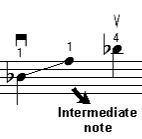
Maybe you are now good at playing simple melodies with notes on the lower range of your violin or viola. How do you play those really high notes next? The answer is, you need to learn how to "shift" to different positions.

Shifting is one of the most critical skills in learning to play a stringed instrument. 1st position is the basic starting position you learn first. Each higher position moves your hand one finger position higher on the finger board.
For example, here is an image of a person's hand in "1st position." You can see tape marking where the 2nd and 3rd fingers should press the fingerboard while in first position (the thumb is covering the tape marking where the 1st finger should press the fingerboard).

Image Source: https://violinspiration.com/the-ultimate-guide-to-the-violin-positions-with-free-pdf-charts/
Here is an image of a person's hand in "3rd position." You can see that the person's first finger is now over the 3rd tape marking.

Image Source: https://violinspiration.com/the-ultimate-guide-to-the-violin-positions-with-free-pdf-charts/
Here are some practice tips for shifting beginners. These tips can be used up to 4th position.
Make sure you keep your wrist straight as you shift. The shape of your wrist will affect the accuracy of your playing.
When shifting, follow these basic steps:
Loosen the pressure of the finger you just used to play a note, so it is gently still touching the string.
Slide your whole hand, with the finger gently on the string, up to the new position.
Then press down again on the string in the new position to play your new note.
Here is a video showing the basic loosen and slide motion involved in shifting:
https://youtu.be/eToN04JlivU?si=-djqge7zDs7CSViD
Remember, for 1st through 4th positions, you slide your thumb along the neck when you shift. You keep your thumb aligned with your first finger as you slide up and down. If your hand keeps sticking to your instruments’ neck when you try to shift, you may be gripping it too hard. Loosen your grip to make sure your whole hand slides up and down easily. You can practice sliding up and down on your instrument, playing close attention to your arm and hand shifting up and down smoothly.
Here is another video showing a set of recommended exercises for improving this skill.
Source: https://youtu.be/t-kTwSJiAiw?si=Vn1vc2GbGRFoHbjE&t=267
We'll have more on shifting in our next post.





